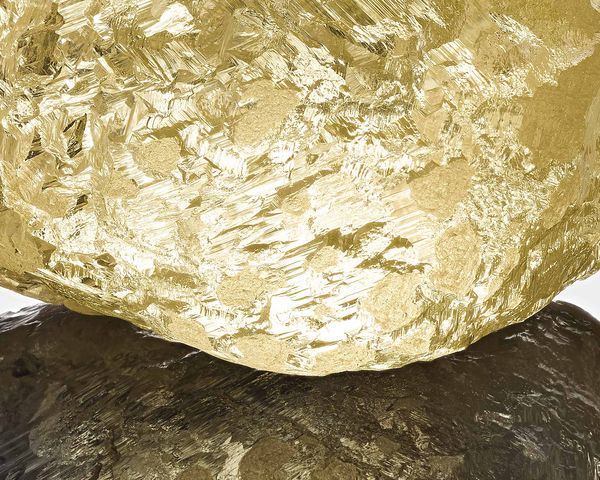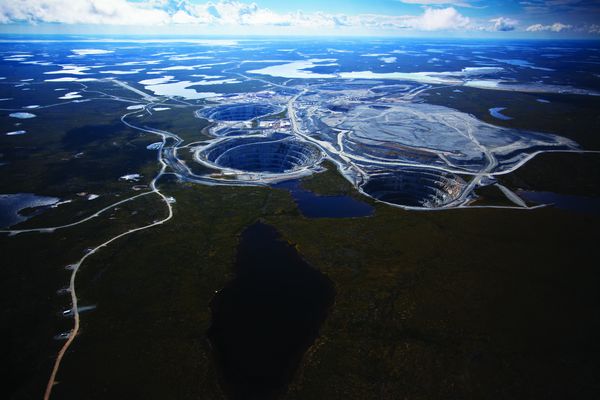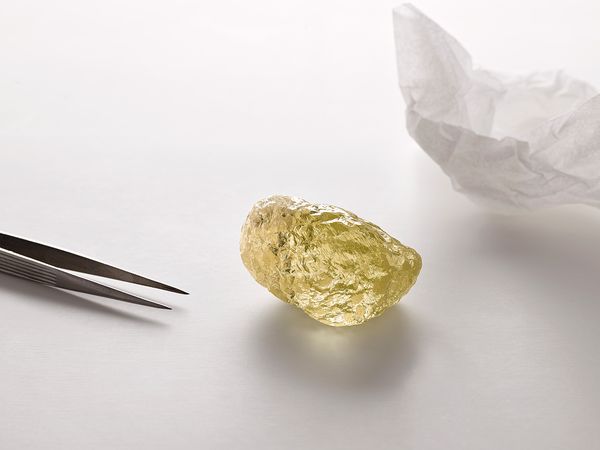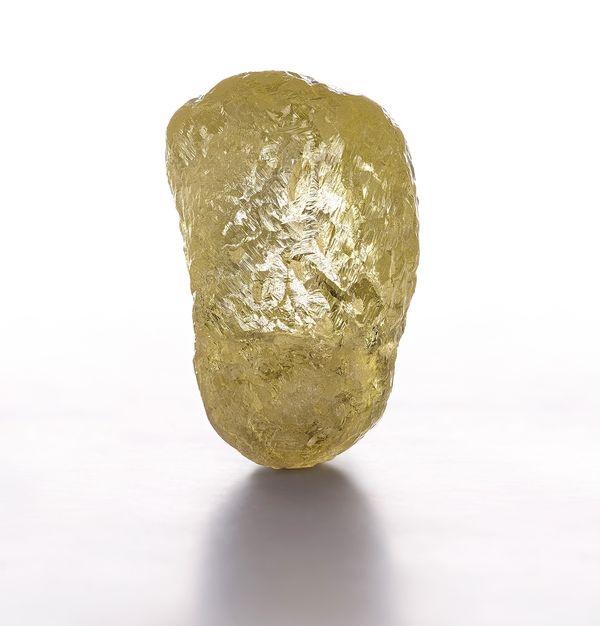The journey of a diamond is complex and beautiful. The 552-carat diamond, discovered at the Diavik Mine in Canada last October, is the largest diamond unearthed in North America. This jewel of nature is astonishing not only for its weight, size, age and color but also for its formation, its part in history and how it was found. Phillips is honored to exhibit this natural wonder.
Diamonds form in the Earth's upper mantel, between 90 and 140 miles under the surface, where the ideal temperature and pressure conditions exist for carbon to form strong bonds, creating diamond crystals. This formation occurs under ancient, large and stable parts of a landmass, called a craton. Diamonds may wait hundreds of millions of years before they are transported to the surface by Kimberlite and Lamproite. These two rocks carry diamonds to the surface in a rapid and violent explosion, thereby creating a vertical cone formation called a pipe. Unlike a slow lava flow from a volcano, the molten rocks solidify immediately and fall back, leaving their cargo in the pipe and creating a shallow crater on the surface.
However, not all pipes are diamondiferous, or diamond-bearing, nor do most contain diamonds worth mining due to their quantity or quality. Most of the diamonds that are found today were delivered to the surface between 2.5 billion and 20 million years ago. In the last twenty years, geologists, gemologists and geochemists have found examination of rough diamonds important because they are the oldest and deepest samples of Earth that can be obtained. Through examination with advanced technology, the mineral inclusions in diamonds tell a story about formation conditions, host rock for growth, the sources of diamond-forming fluid and the age of a diamond. Inclusions are often removed when a diamond is cut and polished, making it more difficult to understand their past. It has been determined that the age of this diamond is approximately 3.1 billion years old, making it older than a vast majority of diamonds unearthed in this region of Canada.
...an outstanding number of large rough diamonds have been unearthed in the last fifty years with the aid of advanced technology.
The Diavik Diamond Mine in Canada's Northwest Territories
Aside from age, the 552 is noteworthy because of its size, which is now ranked 25th on the list of the world's largest rough diamonds, just ahead of the Lesotho's Letseng Star, weighing 550 carats. The list of rough diamonds is dominated by stones mined in Africa. This may be a reflection of the abundant indigenous resources, the years dedicated to mining, accessibility, changes in technology, climate and the number of mines currently under production in Africa. Several large rough diamonds have also been produced in Russia as well. What is apparent from this list is that an outstanding number of large rough diamonds have been unearthed in the last fifty years with the aid of advanced technology.
Modern mining in Canada on a large scale is more recent with the first mine, Ekati, opening in 1998. Shortly thereafter, the Diavik Mine opened in 2003. However, most trace the beginning of mining in Canada to Professor Hobbs, in 1899, when he theorized that diamonds in the Great Lakes states came from Canada more than 20,000 years ago through glaciation. Even with the isolated discovery of diamonds in North Carolina, circa 1840, it was not until the 1960s that serious diamond exploration began in Canada. This process was slow because it was hampered by climate, short seasons and remoteness. In 1981, numerous kimberlite pipes were discovered in Canada, and ten years later a diamond-bearing kimberlite was discovered in the Lac de Gras area. Today, more than half of the kimberlite pipes that have been found in Canada are diamondiferous.
Based on examination of this diamond by the head geologist at Diavik, the 552 exhibits evidence of resorption on the stone, or evidence showing that the stone was originally much larger and probably a different shape. The process by which the diamond came to the surface wore away some of the material, changing its shape and diminishing its size. While the find of the 552 was unexpected because of its size and color, the same locale also yielded the Foxfire Diamond, weighing 187.63 carats. This rough was cut to yield two pear-shaped diamonds weighing 37.87 and 36.80 carats. This find opens the possibility for Dominion Diamond Mines to produce other significant stones.
The yellow color of the 552 is also an anomaly.
The yellow color of the 552 is also an anomaly. While it is not unusual to find the presence of nitrogen (the element that causes the yellow color) in the crystal structure of diamonds, Diavik's diamonds are known for their high quality of colorless diamonds – D-E-F color and VS or better clarity. Yet the mine also produces diamonds in different shades of brown, orangy-browns, yellows and even some small light pink and light purple stones.
Diamond extraction, or recovery, is a process that begins when ore from the kimberlite pipes is brought to the processing plant. Once there, the ore undergoes crushing which reduces its size. The ore is scrubbed to remove dirt and particles of clay before moving into a variety of separation processes to isolate the rough diamonds from other minerals. Therefore, it is remarkable that the 552 survived the recovery process, especially because Diavik's processing plant is optimized for the recovery of smaller diamonds.
An ice highway supports the sustainable Diavik Diamond Mine in Canada's Northwest Territories
Constructing and maintaining one of the most important diamond mines in the marketplace is more complex than ever before. Once a pipe has been located and established as diamondiferous, a decision is made regarding profitability. This includes not only the quantity and quality of the diamonds but also the construction of the mine, operation, maintenance and reclamation of the land, as well as all support services. Dominion Diamond Mines is invested in the big picture — creating jobs, sustainability, economic opportunity, social, cultural and ethical responsibility; more than 50% of the employees are indigenous people or local to the Northwest Territories. Undoubtedly, the remoteness of this contained but highly mechanized business is responsible for being one of the most important diamond sources.
The 552: North America's largest yellow diamond is on view at 450 Park Avenue from Thursday 31 January through Sunday 3 February 2019.




